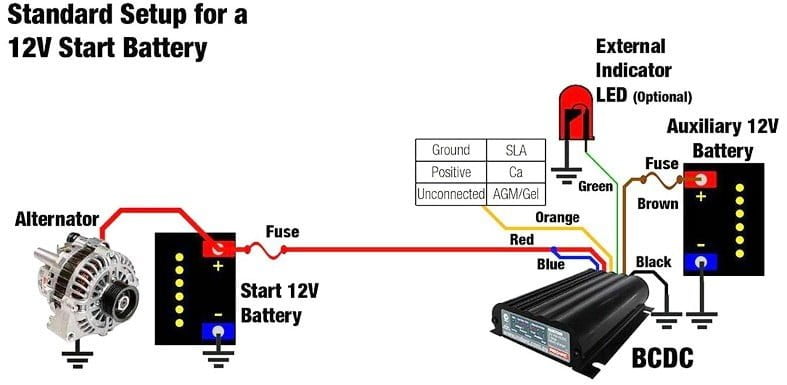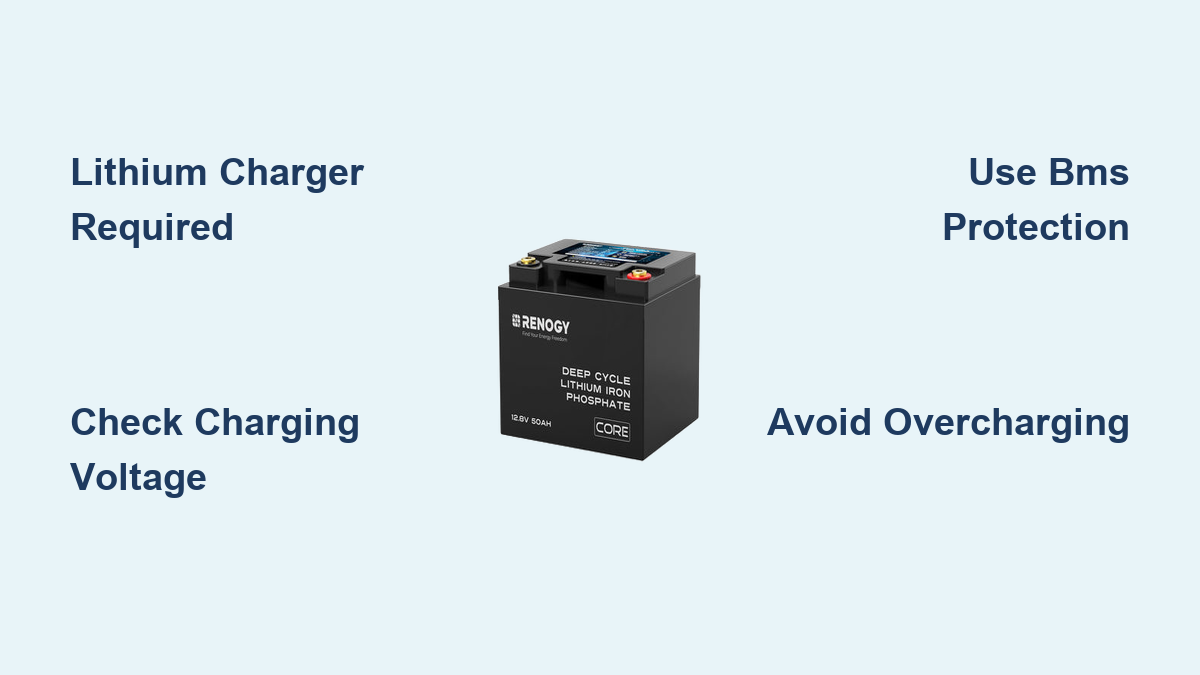Are you frustrated trying to figure out how to properly charge your Renogy lithium battery? It’s a common issue – lithium batteries require different charging methods than traditional lead-acid batteries, and getting it wrong can damage the battery or reduce its lifespan. The good news is, a simple understanding of the correct charging profiles and equipment can get your Renogy battery back to 100% quickly and safely.
This comprehensive guide will walk you through everything you need to know about charging your Renogy lithium battery, from understanding the different charging methods to troubleshooting common problems. We’ll cover optimal charging voltages, compatible chargers, and essential safety precautions, ensuring you can maximize the performance and longevity of your investment. By the end of this article, you’ll be confident in your ability to charge your Renogy lithium battery effectively and avoid costly mistakes.
Understanding Renogy Lithium Battery Charging
Lithium vs. Lead-Acid Charging
Renogy lithium batteries (LiFePO4 chemistry) differ significantly from lead-acid batteries. Lead-acid batteries require a multi-stage charging process with equalization, while LiFePO4 batteries prefer a constant current/constant voltage (CC/CV) charge profile. Attempting to charge a lithium battery with a lead-acid charger can lead to undercharging, overcharging, or even damage.
Optimal Charging Voltage & Current

- Bulk Charge: The battery is charged at a constant current until it reaches the absorption voltage. For a 12V Renogy lithium battery, this is typically around 14.2V-14.6V.
- Absorption Charge: The voltage is held constant while the current decreases as the battery nears full capacity.
- Float Charge: The voltage is reduced to a lower level (typically 13.5V-13.8V) to maintain a full charge without overcharging.
- Charging Current: Renogy batteries typically recommend a charging current of 0.2C to 0.5C (where C is the battery’s capacity in Amp-hours). For example, a 100Ah battery would ideally be charged between 20A and 50A.
Battery Management System (BMS)
Renogy lithium batteries have a built-in Battery Management System (BMS). The BMS protects the battery from overcharge, over-discharge, over-current, short circuits, and extreme temperatures. It’s crucial not to bypass the BMS.
Methods for Charging Your Renogy Lithium Battery
Method 1: Using a Lithium-Specific Charger
This is the recommended method for charging your Renogy lithium battery.
Diagnosing the Issue:
Ensure your charger is specifically designed for LiFePO4 batteries. Using the wrong charger is the most common mistake.
Fix Steps:
- Connect the Charger: Plug the lithium charger into a standard AC outlet and connect the charger clips to the battery terminals (red to positive, black to negative).
- Monitor Charging: Observe the charger’s indicators. A lithium charger will typically indicate bulk, absorption, and float stages.
- Full Charge: Allow the charger to complete the charging cycle. The BMS will prevent overcharging.
Testing:
Use a multimeter to verify the battery voltage reaches the appropriate absorption voltage (14.2V-14.6V for a 12V battery).
Method 2: Solar Charging with a Compatible Charge Controller

Solar charging is an excellent way to maintain your Renogy lithium battery.
Diagnosing the Issue:
Confirm your solar charge controller supports LiFePO4 battery profiles. Many MPPT charge controllers are compatible but require programming.
Fix Steps:
- Program Charge Controller: Access the charge controller’s settings and select the LiFePO4 battery profile. Input the correct charging voltages (absorption, float).
- Connect Solar Panels: Connect your solar panels to the charge controller.
- Connect Battery: Connect the charge controller to the Renogy lithium battery.
- Monitor Charging: Monitor the charge controller’s display to track the charging progress.
Testing:
Verify the charge controller is delivering the correct voltage to the battery using a multimeter.
Method 3: Charging from a Vehicle’s Alternator

Charging from a vehicle’s alternator is possible, but requires caution.
Diagnosing the Issue:
Most vehicle alternators output a voltage suitable for lead-acid batteries (around 14.4V). This can work for lithium, but prolonged exposure to this voltage can shorten battery life.
Fix Steps:
- DC-DC Charger: Highly recommended. Install a DC-DC charger between the alternator and the battery. This charger converts the alternator’s output to the optimal voltage and current for LiFePO4 charging.
- Direct Connection (Not Recommended): If a DC-DC charger isn’t used, connect the battery to the vehicle’s alternator terminals (red to positive, black to negative). Monitor the voltage closely.
- Limit Charging Time: Avoid prolonged charging from the alternator without a DC-DC charger.
Testing:
Use a multimeter to monitor the battery voltage during charging. Keep the voltage below 14.6V.
Pro Tips for Renogy Lithium Battery Charging
- Temperature Considerations: Lithium batteries shouldn’t be charged below freezing (32°F/0°C). If charging in cold temperatures, use a heated enclosure or move the battery to a warmer environment.
- Storage Charging: When storing the battery for extended periods, charge it to approximately 50-60% capacity.
- Equalization is Harmful: Do not attempt to equalize a Renogy lithium battery. This will damage it.
- Use Proper Cable Gauge: Use appropriately sized cables to minimize voltage drop, especially for longer runs.
- Regular Monitoring: Regularly check the battery voltage and charging status to ensure optimal performance.
- Avoid Partial State of Charge (PSOC) for Long Periods: While LiFePO4 batteries tolerate PSOC better than lead-acid, consistently leaving them at a low state of charge can reduce their lifespan.
When to Seek Professional Help
- Battery Swelling or Damage: If you notice any physical damage to the battery, such as swelling or cracking, discontinue use immediately and consult a professional.
- BMS Failure: If the BMS is not functioning correctly (e.g., not protecting against overcharge), contact Renogy support or a qualified technician.
- Unusual Heat Generation: If the battery becomes excessively hot during charging, there may be an internal issue.
- Consistent Charging Issues: If you’ve tried multiple troubleshooting steps and are still unable to charge the battery properly, seek professional assistance.
FAQ
Q: Can I use a trickle charger on my Renogy lithium battery?
A: No. Trickle chargers are designed for lead-acid batteries and may not provide the correct charging profile for lithium batteries. It’s best to use a lithium-specific charger or a compatible solar charge controller.
Q: How long does it take to charge a Renogy lithium battery?
A: The charging time depends on the battery capacity, the charging current, and the initial state of charge. A general rule of thumb is 8-10 hours for a full charge from a depleted state using a compatible charger.
Q: What happens if I overcharge a Renogy lithium battery?
A: The BMS will prevent overcharging, but repeated overcharging can still degrade the battery’s performance over time.
Q: Can I parallel charge multiple Renogy lithium batteries?
A: Yes, but it’s crucial to ensure all batteries are the same voltage and capacity. Use a battery balancer to ensure even charging.
Get Your Renogy Battery Working Again
By following these guidelines, you’re well-equipped to charge your Renogy lithium battery safely and effectively. Remember to prioritize using a lithium-specific charger or a properly programmed solar charge controller, and always monitor the charging process.
- Understand the optimal charging voltages and currents.
- Utilize the BMS for protection.
- Consider temperature and storage best practices.
Have you successfully charged your Renogy lithium battery using these methods? Share your experience or any questions in the comments below to help other Renogy users!

